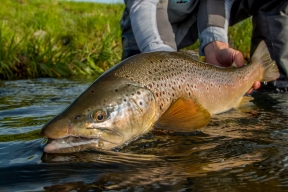
This winter was a doozy. It was exactly what we needed to get us out of a dire water situation. It’s still happening. Yesterday, April 18, the Jackson Pass was again closed and traffic was held up for several hours due to a weather related accident. Closed highways due to heavy snow was a common occurrence. I live on a private lane. We were snowed in 3 subsequent Wednesdays in February and March. With that in mind we can expect much better fishing conditions but we’re not out of the woods. We always look at snowpack and SWE (snow water equivalent) which is important for the short term which can change dramatically year to year. One statistic I always pay attention to is natural flow which currently sits at 66% of average. I expect this to improve but it is doubtful it will bring us up to average. To get there we’ll likely need another year or two of above average snowpack.
Another factor that determines our water year is spring weather. It hasn’t been uncommon for us to go into spring with above average snow pack only to have it erased by a warm, dry April and May. I’m encouraged this year with below normal to near normal temperature and precipitation for the next 10 days. The snowpack is much like a storage reservoir. When the weather is wet and cool it allows water to flow consistently. When it gets warm and dry, it opens the gates to let this stored water flow without any control. So far this looks like the kind of water year that we all hope for.
I can’t make a very accurate prediction about what fishing will be like for the upcoming season until I have a pretty good insight on how the snow water equivalent and the rate it will melt. With that in mind I think I have enough information to for a seasonal fishing forecast. I can only predict the first month of the season because it is anybody’s guess what it will be like after that.
Upper Henry's Fork
There is plenty of water to fill Island Park Reservoir. Couple that with our late spring and we should have very good early season conditions. In fact, the Henry’s Fork Foundation along with the water users plan a “spring freshet” which will allow a flow of 2000 cfs to flow from the Island Park Reservoir for a 24 hours, enough time to clean out a lot of silt and sediment that has been deposited in the Box Canyon, and especially the ranch, over the past several years. Aquatic insects need clean gravel which will likely benefit the hatches for the next season or two. The question is will a full reservoir and lower storage demand improve the turbidity problem that plagued this section of the river last season?
I expect our hatches to be late, at least by the ranch opener on June 15th. Early on you should expect to see March Browns, Blue Winged Olives and early season caddis. The PMDs, Green Drakes and caddisflies likely won’t come into play until later in June. The water might be pretty high depending on the timing of the runoff.
The salmonflies likely won’t progress up the river through the Riverside Canyon into the Box Canyon until early in June.
Lower Henry's Fork
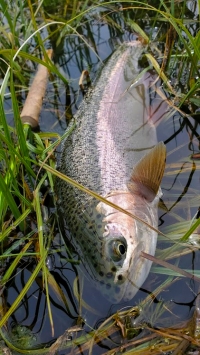
Things have started off very slow. Some of the boating accesses are still closed due to snow requiring some ambitious anglers to drag their boats to and from the river. We’re just now starting to see some Blue Winged Olives. Mother’s Day is May 14th which should put one of the most important caddisfly hatches on the date that bears its name. The question is, will the lower river be fishable. I doubt it.
This should be a great salmonfly hatch. Last year the water was too low, the hatch was too early, and the weather was too bad for decent salmonfly fishing. I wouldn’t give the 2022 salmonfly more than a D+. There is little doubt, in my view, that the river will be in great shape for the salmonfly hatch in late May. I always make a calculated predication on when the salmonflies will first make their presence known at the Vernon Bridge. This year I’m making the call of May 23rd.
Weather and water will determine when our mayflies and caddisflies show up. These hatches won’t likely be very intense until mid-June but the fishing should be fantastic when everything gets underway. Look for the larger Green Drakes followed by their small cousins, commonly called Flavs soon after. I’ve got my fingers crossed that this could be a decent Gray Drake year. I doubt we’ll ever see the intensity of the Gray Drakes like we had in the old days mostly due to changing irrigation practices. The last intense Gray Drake action occurred in 2011.
When circumstances occur with high water, minor flooding, and late season emergence, the big mayflies can produce exceptional dry fly fishing. This could be one of those years.
South Fork
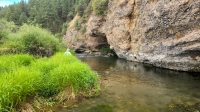
Given our big winter one would expect heavy runoff with very high stream flows on the South Fork. That probably won’t be the case given the fact that as of this date, Palisades Reservoir is only 39% full and Jackson Lake is at 25% of capacity. The snowpack on the Idaho side has improved to 118% of normal Snow Water Equivalent over the past month. The situation isn’t as good on the Wyoming side of the hill. However with the right conditions both of these important reservoirs will fill. It isn’t likely that a heavy flush to pass runoff will occur this year.
Last year the salmonfly hatch on the South Fork was intense but I thought fishing was only about average. It could have been because there were so many stoneflies emerging that the trout filled up on them by the time the hatch blew through. The mayfly hatches in the riffles were very spotty. Fishing was pretty good throughout the season with dry/dropper rigs but I like wade fishing for rising trout. Hopefully that will happen this year but not before the end of June.
Teton River
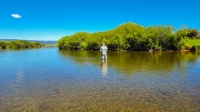
This unique undammed river is both a spring creek and freestone stream. There is plenty of snow in the Teton drainage to expect a lot of water early on which will render the river high and dirty. Once most of the runoff clears, likely about the end of June, dry fly fishing with PMDs, BWOs, Golden Stones and Yellow Sallys should provide great dry fly action.
Madison River
The snowpack in the Madison and Gallatin drainages is similar to the Henry’s Fork. Hebgen Lake is already at near average capacity. The runoff will likely back the best fishing up until later in June. Look for the salmonflies to start showing up near Ennis by the 20th of June. All in all we expect the Madison to not disappoint. July should be outstanding.
Yellowstone Park
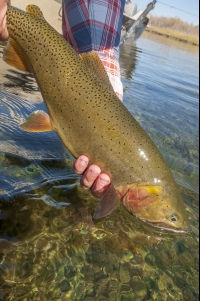
The Firehole is usually the best when the park opens for fishing on Memorial Day weekend. This year it might be a bit high and off-color but you can usually still catch trout on nymphs, streamers and soft hackles. You should expect PMDs by the second week of June. The Madison and Gibbon will also be good later in June. The Yellowstone River opens on July 15th. This year the water will be high making it difficult to wade across even for the most athletic, young, crazy anglers. The last two weeks of July should produce great dry fly fishing with salmonflies, Golden Stones, caddis, PMDs and Flavs. The downside of fishing the Yellowstone is the traffic. Your best option will be to go in early, before the tourist traffic intensifies. Expect heavy traffic on your way out of the park, especially with Buffalo jams. Bring a book in case you encounter a Grizzly jam.
Even though it might have a late start we expect great fishing through the season ahead.